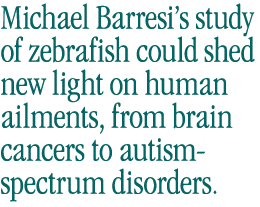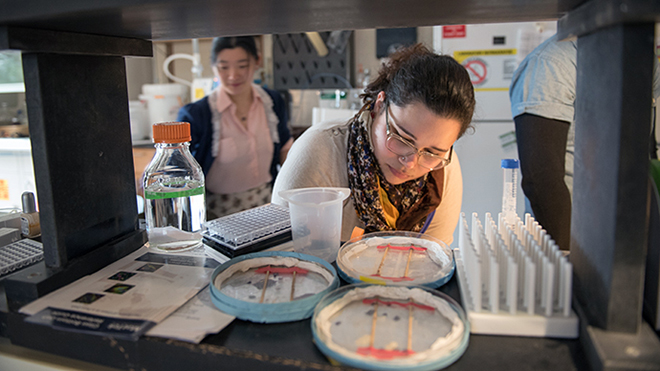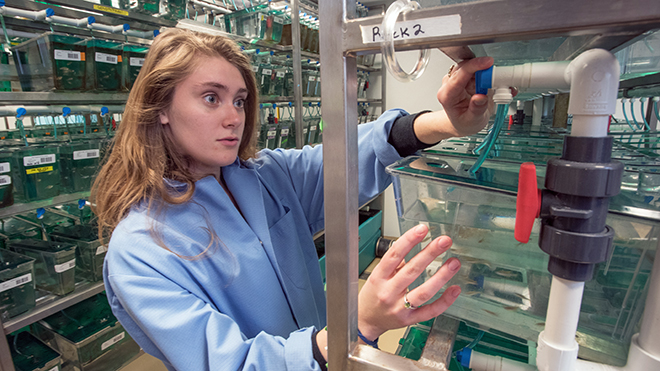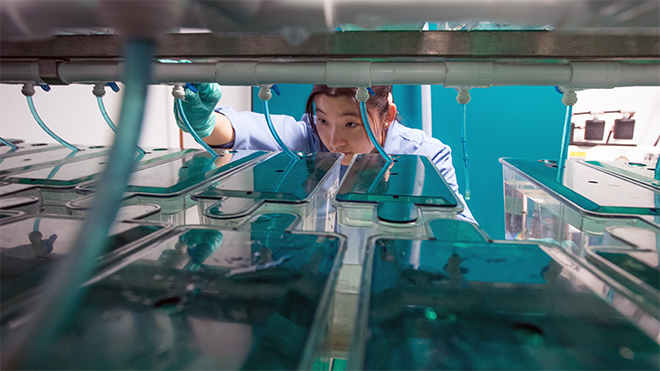

In Smith’s Zebrafish Research Center, Michael Barresi, associate professor of biological sciences, depends on a dedicated team of undergraduates and graduate students to transform research into novel discoveries. Above: Barresi and graduate student Carla Velez survey the fish in mating chambers to determine whether they have produced any embryos. Velez is conducting a project on neural stem cell development.

/ Published January 7, 2016

Shelf after shelf of tiny striped fish meet the eye in the Smith College Zebrafish Research Center, where they swim in clear containers resembling the stacks of drawers for nails and screws at a hardware store. But here, fresh, warm water circulates through each drawer.
“These fish are living in a spa, where everything in the world is perfect,” jokes Michael Barresi, center director and Smith associate professor of biological sciences, as he fiddles with a supply tube. “The water is perfect, the food is almost too expensive.”
But Barresi is quick to add that coddling the fish is worth it. These creatures, each no bigger than dime-store candy, could provide a new basic understanding of human ailments ranging from brain cancers to autism. That’s because processes in zebrafish development from egg to adult are remarkably similar to those in human growth, Barresi notes. The fish make an ideal living laboratory to probe the earliest stages of cell growth and maturation and to explore how those processes can go wrong at the genetic level.
Barresi is now expanding the facility to increase collaborative use by other Smith faculty and create a unique hub of interdisciplinary research. Recently, Barresi received a $354,000 grant from the National Institutes of Health. The grant will largely support his research on spinal cord development, examining the role of neural stem cells.
“We are able to sever the spinal cord, and the absolutely amazing ability in zebrafish is they can regenerate,” says Barresi (unlike in humans where spinal damage is permanent). “So how do they do that?” He plans to study how stem cells affect regeneration and also investigate how genetic defects can yield brain tumors.
But part of the money, alongside $50,000 in matching funds from Smith, will go to increasing the number of fish currently housed in the lab, from 15,000 to a projected 35,000. So far, ten other faculty members have submitted preliminary proposals to begin using the zebrafish in their research and teaching.
The grant offers “a moment to actually envision something substantial—to enable the benefits of the facility to become available to other researchers here at Smith,” Barresi says.

Graduate student Carla Velez (foreground) and Gina Cho ’17 (background) conduct laboratory procedures to label specific cells in the zebrafish nervous system so they can be viewed under microscopes later.
Sharing the Science
Since last fall, Tippit Professor in the Life Sciences Mary Harrington has used the Zebrafish Research Center for her teaching and research on circadian rhythms, or sleep-wake cycles. She uses a group of specially designed zebrafish with a firefly protein attached to their circadian gene.
The gene causes the fish to bioluminesce each time their circadian clock turns on. Harrington and her students can add drugs to the water, then observe changes in the fish’s circadian rhythms to explore sleep-related disorders like depression.
Zebrafish are ideal for this type of research, she explains. “They’re transparent, so light just comes right out of them.”
Barresi and Harrington note that zebrafish have certain advantages over mice and rats as model organisms for human disease. A female zebrafish can lay a whopping 200 to 300 eggs a week. Researchers can manipulate the parent fish’s genes to produce large numbers of mutant offspring. By comparing how gene mutations affect many embryos during development, researchers can have greater confidence that those effects hold true across a broad population, and are not just due to individual variation.
Also, the young fish mature completely outside the parent in water, where drugs are easily added. Because the embryos are transparent, the whole process can be easily observed under a microscope. Moreover, zebrafish babies mature lightning fast, with nervous systems that fully develop in just 17 hours, so experiments can be quickly watched and repeated.
“It’s easy for students to dream up an experimental design,” says Barresi. And zebrafish make it “really accessible for students.”

Vivian Morris ’18 tends to a fish rack in the Zebrafish Research Center, turning off the flow of water so she can pull out that tank of zebrafish to work with them. Her research focuses on studying how the nervous system first gets wired in the embryonic brain.
Endless Research Opportunities
Barresi uses the zebrafish in all his laboratory courses. Most importantly, he employs the fish in research-based courses, where students learn through designing, proposing and carrying out their own novel research projects.
These efforts have already produced exciting results. In 2010, the BP Deepwater Horizon oil rig exploded and released more than 200 million gallons of oil into the Gulf of Mexico, making it the worst environmental disaster in U.S. history. Barresi decided he and his students would examine the oil’s effect on developing zebrafish to see how oil might harm other young fish in the Gulf, a major breeding ground for economically important species like tuna.
Just two weeks before the beginning of the semester, samples of crude oil from the rig arrived. Barresi’s class exposed zebrafish to the oil and discovered that the fish suffered a variety of previously unreported defects, including cell death and problems in mobility.
They also discovered the likely neuronal source of defects, observed by other scientists, in the fishes’ skulls and circulatory systems. Barresi and his class published their findings as co-authors in the May 2012 issue of BMC Biology.
More recently, Barresi has engaged a class of students in an investigation of genes related to autism. The students plan to “knock out” or silence genes in which malfunctions are thought to lead to autism-spectrum disorders, then watch developing zebrafish brains for changes. They’ll also observe the fish for erratic behavior. Increased activity or failure to school might indicate features of autism like anxiety or difficulty interacting socially.
Barresi says that to his knowledge, the Smith Zebrafish Research Center is the largest zebrafish facility at a liberal arts school. Over 80 percent of the students who have spent a year or more in his laboratory have gone on to graduate study, and all but one of the rest have attended medical school.
“Students that get trained in zebrafish, those students are getting an extremely unique experience that few other students at liberal arts schools are getting,” he says. “They’re getting tangible skills that they’ll be able to bring to that interview and that job.”

Gina Cho ’17 reaches to adjust the flow of water to the “baby fish” tanks. Her research focuses on understanding the embryo-disrupting properties of environmental toxins associated with fossil fuels, particularly those that affect nervous system development.














